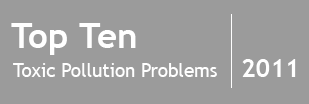Lead-Acid Battery Recycling
Lead Pollution
Estimated Population at Risk:
1 Million
Description
Lead-acid batteries are rechargeable batteries that are widely found throughout the world and are commonly used in motor vehicles. These batteries are made up of lead plates and sulfuric acid that are contained within a plastic cover. The lead plates are perfect for use in batteries because of their ability to be recharged multiple times. After sustained use, the lead plates eventually weaken and are no longer able to store energy.46 Used lead-acid batteries (ULABs) are either discarded or recycled. Because of the toxic materials within these used batteries, the Basel Convention has included ULABs on its list of materials classified as “hazardous waste.”47
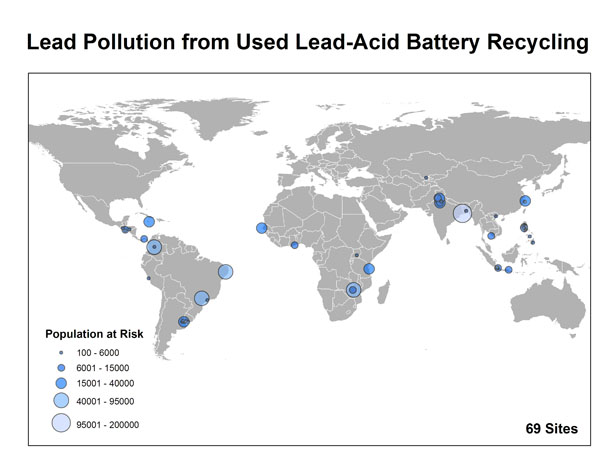
Populations estimates are preliminary and based on an ongoing global assessment of known polluted sites.
Industrial Process
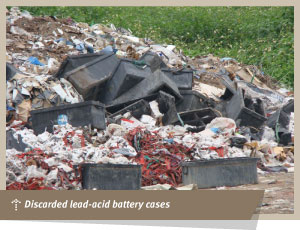 Though the lead plates in a ULAB have been exhausted, this does not mean that the lead within the battery cannot be reused. In fact, most new lead-acid batteries contain up to 80% recycled, purified lead – making recycled lead a very valuable material.48 Because of the success of recycled lead, the market for extracting and reselling used lead has grown substantially, particularly in low- and middle-income countries. Though high-income countries have developed safe and effective processes for the reclamation of lead from ULABs, the recycling process that occurs throughout much of the rest of the world is far less developed and regulated.
Though the lead plates in a ULAB have been exhausted, this does not mean that the lead within the battery cannot be reused. In fact, most new lead-acid batteries contain up to 80% recycled, purified lead – making recycled lead a very valuable material.48 Because of the success of recycled lead, the market for extracting and reselling used lead has grown substantially, particularly in low- and middle-income countries. Though high-income countries have developed safe and effective processes for the reclamation of lead from ULABs, the recycling process that occurs throughout much of the rest of the world is far less developed and regulated.
Unregulated recycling industries and informal methods of extracting lead – often conducted in homes or backyards – can lead to high levels of environmental lead contamination. These processes usually involve breaking the ULABs open by hand or with an axe, which can lead to direct dermal contact with lead and the improper release of battery acid into the surrounding soil. Pieces of the broken batteries are then left on the ground where they are exposed to the elements and can possibly spread toxins to people through dermal contact. Once the batteries are broken open, parts of the battery must be melted in order to recover the secondary lead. This process is frequently performed in homes and over informal kitchen stove flames. Lead-oxide, which accounts for 40 percent of the lead weight in each battery and is a particularly bio-available form of lead, is often improperly disposed of and left out in the open.
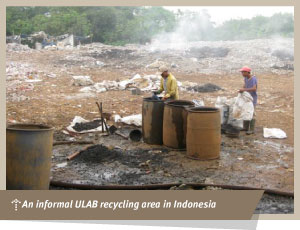 Global Context
Global Context
On an annual basis, nearly 6 million tons of lead are used around the world, with over 4 million tons used in lead-acid batteries. Substantial quantities of this lead consumption come from recycled materials and ULABs, which, when done properly, is a very effective industry in terms of reducing lead pollution and the need for mining of virgin ore material. Recycling of secondary lead, however, when done without proper regulations or safety measures, can be very dangerous and can lead to high levels of toxic exposure for both those directly involved and for surrounding communities.
Because of the growing market for secondary lead, many low- and middle-income countries have begun to buy ULABs in large quantities in order to recover and resell the material. Many of the ULABs originate in industrialized countries and are shipped long distance in order to be recycled.49 Today, ULAB recycling processes occur in nearly every city in low- and middle-income countries, with many of the recycling and melting operations taking place in densely populated urban settings.
A large amount of the recycling processes in these countries, both small- and large-scale, is done with little knowledge of the health impacts these processes have. In many places, there are no environmental or health regulations that govern recycling, and lead is often released into the environment in very high quantities. Informal recycling is also disproportionately performed by people living in conditions of poverty who may not have other viable means of income and who are often unaware of the dangers posed by these operations. Currently, the Blacksmith inventory estimates that almost 1 million people are affected by lead pollution from ULAB recycling, with the most severe problems observed in South America and South Asia.

Exposure Pathways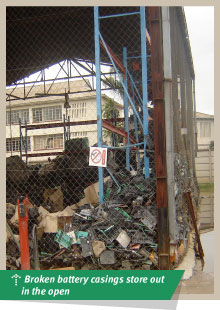 The informal recycling processes for ULABs can subject people to various forms of toxic exposure. The most frequent and common way that people are exposed to lead contamination is through lead particulates from the battery acid. During the breaking process, battery acid can easily leak into the soil or enter ground and surface water systems that are used for bathing and drinking. Lead toxins can also be inhaled during the melting of the lead plates, which allows the metal to enter into the respiratory and circulatory systems. Excess lead dust from this process can also be transported on clothing and can accumulate inside houses on bedding, furniture, and even food. Dry soil that is contaminated with lead particulates also poses the hazard of spreading lead dust throughout a community, where it can easily be inhaled or touched.
The informal recycling processes for ULABs can subject people to various forms of toxic exposure. The most frequent and common way that people are exposed to lead contamination is through lead particulates from the battery acid. During the breaking process, battery acid can easily leak into the soil or enter ground and surface water systems that are used for bathing and drinking. Lead toxins can also be inhaled during the melting of the lead plates, which allows the metal to enter into the respiratory and circulatory systems. Excess lead dust from this process can also be transported on clothing and can accumulate inside houses on bedding, furniture, and even food. Dry soil that is contaminated with lead particulates also poses the hazard of spreading lead dust throughout a community, where it can easily be inhaled or touched.
Young children are particularly at risk of lead exposure because of typical hand-to-mouth behavior. Because so many lead battery scraps are left out in the open, children often play in or around these dump sites and can inadvertently pick up stones or soil contaminated with lead, and even bring these objects back to their homes. The most frequent form of lead exposure for children is ingestion, as lead toxins can enter directly into children’s bodies through lead dust–covered hands, food, or toys that are either eaten or brought in contact with the mouth.
Health Effects
Please see health effects from lead on page.
What is Being Done
Though the problems associated with informal ULAB recycling processes and lead poisoning are well documented and recognized under the Basel Convention Secretariat, these practices continue to occur on a very large scale throughout the developing world. Much of the informal ULAB recycling is very small-scale and difficult to regulate or control, but progress can be made through cleanup, outreach, policy, and education. 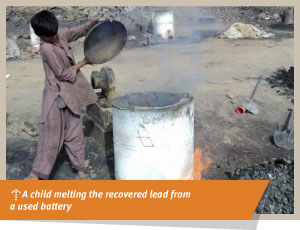
Blacksmith’s Lead Poisoning and Car Batteries Project (formerly the Initiative for Responsible Battery Recycling) is currently in place in eight countries, including Senegal (with co-funding from Green Cross Switzerland), the Dominican Republic, India, and the Philippines. The Project aims to end widespread lead poisoning from the improper recycling of ULABs, and consists of several different strategies and programs, with the most important priority being the health of children in the surrounding communities. The multi-faceted system for mitigating and eliminating lead exposure and informal recycling consists of the following approaches: 1) the blood levels of children in recycling areas are monitored and treatment is provided to those with significantly high blood lead levels; 2) education and avoidance programs are implemented in communities surrounding recycling operations to inform community members of the dangers posed by improper ULAB recycling and to provide helpful advice on how to avoid exposure through inhalation, contact, and ingestion; 3) soil that is already contaminated with legacy lead particulates is either removed or is buried and covered with non-polluted top soil in order to avoid further toxic exposure; 4) programs and discussions take place with local governments and NGOs in order to implement sound policy for regulating and controlling problems associated with informal recycling and exposure; and 5) projects are undertaken with various community members and stakeholders to help create alternative economic opportunities.
Example – DALY Calculations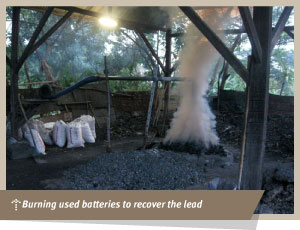
A small town outside of Manila in the Philippines contains a closed battery manufacturing plant and a ULAB recycling facility. Though the plant is guarded, scavengers still sneak in to recover material that may contain reusable lead. This practice, along with waste and toxic spillage from the other recycling facilities, has lead to high levels of lead contamination in the area, and many people are growing their food in soil with high lead pollution. Blacksmith samples found 193,880 parts per million of lead in the soil, which is over 400 times the health standard. Blacksmith estimates that 15,000 people are at risk of exposure to lead in this area.
DALYs associated with adverse health impacts from lead exposure at this site are estimated to be 319,817 for the estimated exposed population of 15,000. In other words, the 15,000 affected people at this site will have a collective 319,817 years lost to death, or impacted by disease or disability. This comes out to 21 years lost or lived with a disability per person.
Footnotes:
[46]: “Used Lead Acid Batteries: Factsheet.” Department of the Environment and Heritage. Australian Government. August 2005. Available at: http://www.environment.gov.au/settlements/chemicals/hazardous-waste/publications/lead-acid-fs.html.
[47]: “The Basel Convention on the Control of Transboundary Movements of Hazardous Wastes and Their Disposal.” Basel Convention. United Nations Environment Programme. Available at: http://www.basel.int/text/17Jun2010-conv-e.pdf.
[48]: “Batteries.” U.S. Environmental Protection Agency. Accessed on August 25, 2011. Available at: http://www.epa.gov/osw/conserve/materials/battery.htm.
[49]: Trade and Environment.“A Teaching Case: The Basel Ban And Batteries.” Accessed October 14, 2011. Available at: http://www.commercialdiplomacy.org/case_study/case_batteries.htm.

-
Artisanal Gold Mining
Mercury Pollution
-
Industrial Estates
Lead Pollution
-
Agricultural Production
Pesticide Pollution
-
Lead Smelting
Lead Pollution
-
Tannery Operations
Chromium Pollution
-
Mining and Ore Processing
Mercury Pollution
-
Mining and Ore Processing
Lead Pollution
-
Lead-Acid Battery Recycling
Lead Pollution
-
Arsenic in Groundwater
Arsenic Pollution
-
Pesticide Manufacturing and Storage
Pesticide Pollution
-
The Rest of the Toxic Twenty

